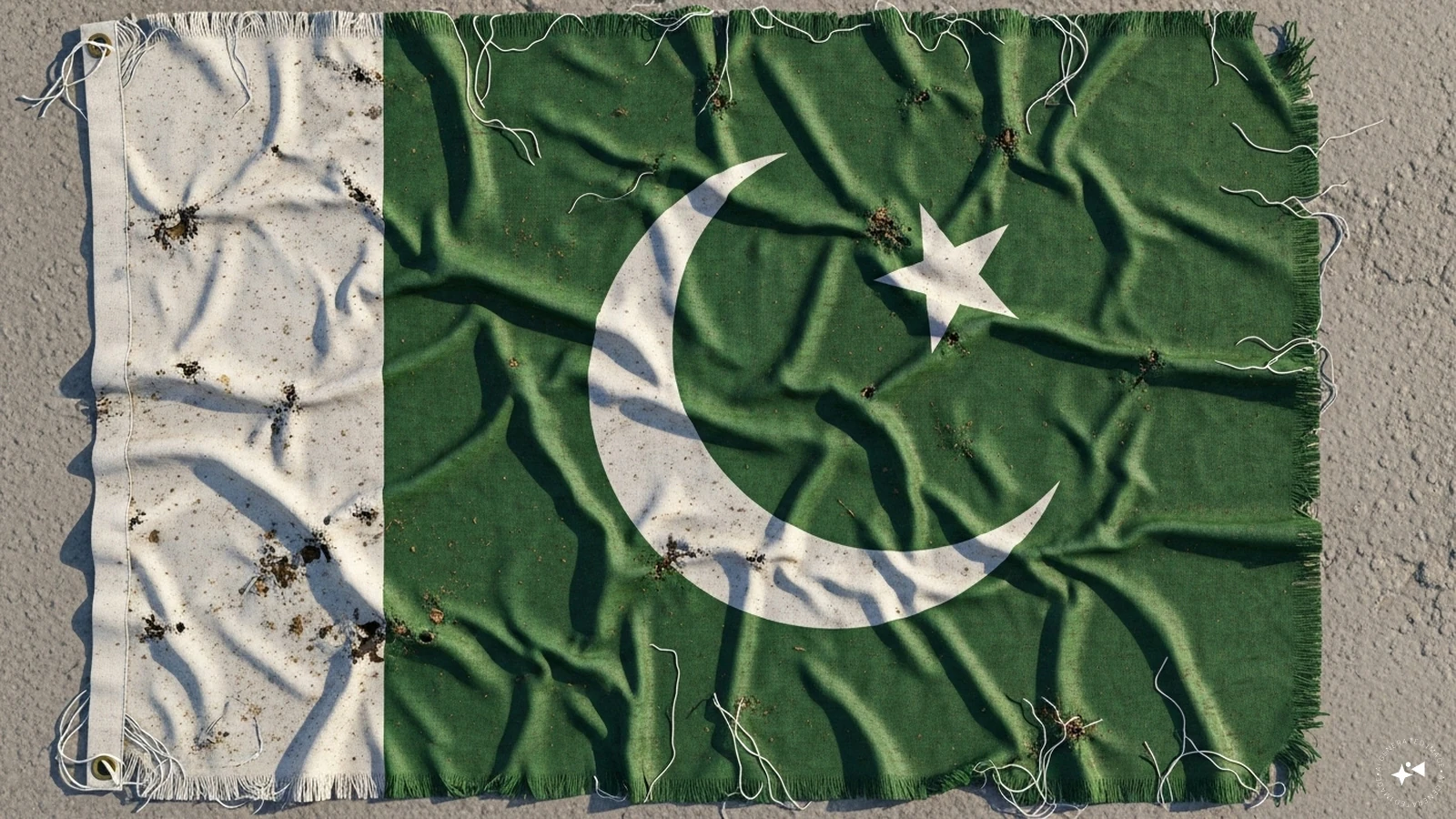Copyright news18

Pakistan today stands at the precipice—a nation confronting internal firestorms, external belligerence, and a self-inflicted economic death spiral. For decades, Islamabad wore “the thousand cuts” doctrine like a talisman, believing proxy war would keep India off balance and its own house secure. Its patronage of jihadis in Afghanistan and its open support for the Taliban were all fulcrumed around the idea of gaining “strategic depth” against India. Now the doctrine’s jagged shards are lodged in Pakistan’s own body. Facing a hostile Afghanistan to its west, an implacable India to the east, and insurgencies that have penetrated even Punjab’s heartland, Pakistan’s most dangerous enemy is no longer India, nor even America, nor the Taliban. It is itself. The terror state that exported chaos now chokes on the fumes of its own fire. Border Wars: Stalemate and Shattered Facade The familiar Hindu Kush terrain, carved by the Durand Line, is again awash in blood. Pakistan, desperate to show muscle and “resolve”, launched airstrikes inside Afghanistan, targeting the Tehreek-e-Taliban Pakistan (TTP). The Taliban responded in kind, decimating Pakistani posts with coordinated attacks and claiming the lives of dozens of Pakistani soldiers. Satellite imagery from Spin Boldak showed compounds reduced to rubble; both sides trumpeted inflated casualty counts as the fighting escalated into the worst clash since the Taliban’s 2021 takeover. Never before has Pakistan seen such a bloody October, and it would not be an overstatement to suggest that this is just the beginning of the terror state’s unravelling. The border war with Afghanistan reveals Islamabad’s strategic bankruptcy as much as operational ineptitude. The Durand Line cuts through Pashtun homes and history—a border Afghanistan never accepted and Pakistan cannot police. Displaced tribes, embittered insurgents, and the ghosts of failed colonial cartography make the region impossible to govern. Attempts to wage “precision” war have only inflamed older resentments. When Pakistan bombs its own villages in pursuit of militants, killing civilians and children in Khyber Pakhtunkhwa, outrage spills into protests, not just over deaths but over the reckless disregard for civilian lives. The only thing being “secured” is Pakistan’s infamy as a state drunk on its own violence. Bleeding From Within: Insurgency Everywhere The TTP is not the only group shaking Pakistan’s foundations. Baloch separatists have taken their fight mainstream, using suicide bombers, including women, and attacking Chinese interests, especially projects tied to the China-Pakistan Economic Corridor (CPEC). The March 2025 Jaffar Express hijacking showcased the Baloch Liberation Army’s sophisticated operational planning, with over 400 hostages captured and 26 left dead. Insurgencies are beginning to ripple into Karachi and spread even into southern Punjab, where gas pipelines and mineral operations are now targets for sabotage. In Balochistan, the crisis goes beyond insurgency: it is the result of decades of exploitation and brutal marginalisation. Disappearances, arbitrary arrests, and entire communities branded “traitors” have left Balochistan impoverished and angry. The Pakistani state now faces a coordinated, multi-faction resistance whose only common thread is hatred for Islamabad’s predatory rule. Khyber Pakhtunkhwa is even worse. This mountainous province is a battlefield, with hundreds of terror attacks reported in 2025 alone. Bombings, assassinations, and gun battles between state forces and militant groups, often spilling over the border, have turned Pakistan’s northwest into a perpetual war zone. Punjab, long considered the bastion of Pakistani power, no longer delivers docile obedience. Massive anti-army, anti-West protests led by the Tehreek-e-Labbaik Pakistan (TLP) and Jamaat-e-Islami have erupted across Lahore and Muridke. News of Pakistani forces grievously injuring TLP chief Saad Rizvi in a failed attempt to kill him set Muridke on fire. The army, which pompously rolled in to punish protesters, has lost the last vestiges of legitimacy even among the Punjabi elite. Hundreds of thousands have rallied not just for Palestine, but against Pakistan’s alignment with US-brokered peace deals and the country’s embarrassing dependency on foreign aid and military handouts. Most Pakistanis are also stunned to see their country’s “Field Marshal” sell their country to the Americans. Economy in Freefall: The Bill Comes Due Amidst all the fire and fury, Pakistan’s economy has entered terminal crisis. Its trade deficit for the first quarter of FY 2025 ballooned to $9.4 billion, with exports plunging as imports soared. As the Pakistani rupee collapses, inflation bites, and foreign investment flees, neither Gulf states nor Western businesses have answered Asim Munir’s call to invest in a country sold as a “frontier opportunity” by generals turned salesmen. Dubious schemes like the army-run Special Investment Facilitation Council have failed to deliver, attracting ridicule rather than dollars. The one exception? Defence spending, which has jumped by 20 per cent in the face of collapsing education, health, and welfare. Pakistan spends more on guns than on teachers, more on bombs than on medicine. The military’s business empire, once the shadow backbone holding the nation together, now itself trembles under the weight of inflation, corruption, and sheer political paralysis. Strategic Folly: The Trump-Munir Flirtation and Beijing’s Fury Pakistan’s Army Chief Asim Munir, seeking new allies, has embraced Donald Trump, offering up rare earths and access to mineral wealth as bait. Trump, ever the dealmaker, has responded with effusive and expected praise, pushing economic deals that bypass civilian government entirely. Pakistan even nominated Trump for the Nobel Peace Prize twice. Meanwhile, China is looking on with suspicion. After all, Munir’s overtures to the US risk alienating Beijing just as Chinese investment in CPEC becomes more tenuous. Trump sees Pakistan’s military, not its state, as “the reliable conduit”. The result: US financial platforms and crypto ventures are brokering deals with the army and not the parliament, which is any case is a glorified rubberstamp council. American transactionalism, while appealing to Pakistani generals, has greatly deleveraged Islamabad and left it without many options. India: The Last Cut For India, the scenes playing out on its West are nothing short of momentous. For decades, Pakistan has tried to bleed India with a thousand cuts. Today, New Delhi is witnessing its enemy unravel on every front. To top it all, India is using the opportunity to constantly remind Pakistan of the scale of the crisis facing it. From Prime Minister Narendra Modi to Raksha Mantri Rajnath Singh, and even India’s service chiefs and the CDS—all are warning Pakistan to not stretch its luck too far, lest it wants its end to be expedited. India’s message is clear—any future cross-border misadventures will be met with overwhelming force. Pakistan’s internal collapse—border wars, insurgency, economic disaster and the army’s loss of control in province after province — leaves it more vulnerable than at any point since its creation. When a nation that exported terror begins to bleed from every orifice—within Balochistan, Khyber Pakhtunkhwa, Punjab, and at the gates of Kabul—the prophecy is fulfilled not by India, but by Pakistan itself. Pakistan’s final act is no grand battle with India, nor heroic resistance against Afghanistan, nor noble protection of Palestinian rights. It is the act of strategic suicide played out on world stage—surrounded, sinking, and splintering. Years of terror have decayed its borders, bankrupted its treasury, and ignited civil war at home. No amount of performative foreign policy can conceal this reality.



